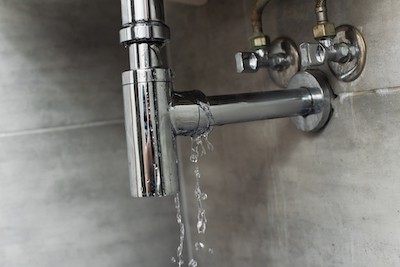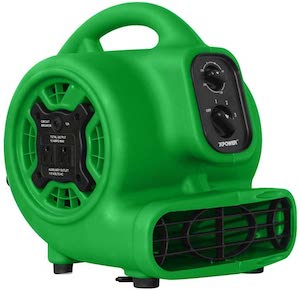If you’re looking for an easy, affordable way of remodeling parts of your home, laminate flooring is an excellent go-to! If you’re interested in roofing, restoration, or renovation in your home, a Broken Arrow Roofing and Construction company can help you with all of your home building project needs!
An advantage to having laminate floors in your home is that they can give your home an elegant, hardwood look. However, a downside to laminate flooring is that it is not waterproof. Because of this, the foundation is more vulnerable to becoming water damaged. If the room is more susceptible to getting wet or you live in a high-moisture climate, it may be worth waterproofing your laminate floors to ensure they’re water-resistant. But what do you do when it’s too late to waterproof your floors and water gets under your laminate flooring?
What Should I Do if Water Gets Under My Laminate Floor?
What happens if I get water under the laminate flooring? Fear not! Moisture under your laminate flooring can be treated. Whether your floor got wet from a leak or your floor was flooded, you can prevent mold from growing and repair your laminate flooring. Wet floors can swell or warp, but you can fix water damage in most cases.
First, you’ll need to start the cleanup as soon as possible. The longer you wait, the more damage your floor with undergo. When you are cleaning up your floor, there are a few things to consider. You’ll want to observe the amount of water. The more water, the less likely you are to be able to save your floor. The longer your laminate flooring is wet, it’ll be less likely that you can save it. The last thing to consider is where the source of the water is. If you have a water pipe that burst or a water tank that flooded, you can usually save it. However, if there’s a leak from the sewage backup or have groundwater flooding that contains mold or bacteria that can pose additional risks, it’s harder to clean up.

Laminate Floor’s Layers
To better understand how water affects your laminate flooring, let’s look at the different layers that make it up. Typically, laminate floors have four layers:
- The backing layer- this is the layer at the very bottom touching the floor. The backing layer helps to balance the board on the subflooring and acts as a moisture barrier.
- The core or base layer- Above the backing layer is the base or core layer. This is the main structure and is usually made from a composite wood material, high-density fiberwood.
- The image or design layer- this layer gives the floorboard the pattern or design. An image is printed on thin paper or in a resin layer that is glued to the base.
- The wear layer- this is the final, top layer made of several layers of clear resin. This helps to protect the board against everyday wear and scratches. This also helps to keep moisture out.
The bottom-most layer is the most vulnerable to water damage. Once it’s ruined, your only option is to replace it. That’s why waterproofing your laminate floor is the best thing you do for it in the long run. Taking preventive measures will save you time and money, as with any home, yard, or property.
 How Damage Occurs
How Damage Occurs
Have no worries if you’ve only spilled a small amount of water on your laminate floor. As long as you pat it dry with a towel, sponge or wipe it dry with a dry mop, you shouldn’t be concerned. However, if a spill occurs and the water is allowed to seep into the cracks or gaps between the laminate floorboards, damage can occur. The wear layer protects against water damage, but as soon as the water goes past this layer, the bottom layer can get wet. This can cause warping, swelling, and mold growth if not treated. If you see bubbles in the gaps, water has gotten through and needs to be treated immediately.
How to Dry Your Laminate Flooring
Depending on the amount of water, you can sometimes easily wipe up water if it’s a small spill. If there’s more water, it’ll take more effort and time to clean up. First, remove any standing water. If they still have water on them, remove it immediately. If there’s less than an inch of water, you can use towels or a mop to mop it up. If there’s more than an inch of water, you’ll need to use a wet-dry vacuum or pump. Next, remove the trim and then flooring. Carefully remove each floorboard. Then, dry each floorboard. You can use dehumidifiers and high-volume fans. Ensure that you keep the boards flat when drying them. If you don’t, they can warp or bend. This makes it harder and sometimes impossible to reinstall.

Make sure that you clean and dry the subflooring. While you’re drying the laminate flooring, use towels to soak up any remaining water on the subflooring. If needed, clean it with soap and warm water. Make sure you disinfect it with bleach and water to prevent mold and odors. Disinfect and clean the floorboards once they’re completely dry. Wash them down with warm water and soap. Individually dry them with clean towels. Next, disinfect them with water and bleach. This will also help to prevent odors and kill mold. Air-dry the boards before you reinstall them. Finally, reinstall your laminate floorboards. If necessary, depending on the damage, you may need to replace some of the panels.
How Long Does it Take to Dry?
If you are using dehumidifiers and high-volume fans, it will typically take anywhere from 12 to 36 hours to dry laminate flooring. This depends on the extent of water spilled, the number of floorboards affected, and the equipment you use. If you use regular house fans, it could take several days to even a week to dry. You should never try and try laminate flooring in its usual place. That will take weeks and can lead to mold and other hazards.
When Should I Replace My Laminate Flooring After Water Damage?
You should always replace water damaged laminated flooring if it’s been in contact with sewage. Contact with a sewage backup can be hazardous to your health because of the risk of bacteria and mold. You should also replace it if you cannot clean up right after a flood. Any warped or swollen boards should also be replaced.
How Soon Does Mold Grow?
Mold only takes 24 to 48 hours to grow. Given the right, moist environment, it would easily thrive. However, if groundwater flooding or a sewage backup occurs, it would only take 12 to 24 hours to grow. Again, the longer you take to clean up, the increased chances of mold and bacteria growth. Mold exposure can cause several health issues, including nasal stuffiness, throat irritation, wheezing, cough, eye irritation, and some skin irritations. Being exposed to mold can also cause sensitivity depending on the nature and time of exposure.
Preventive Measures
To preserve your laminate flooring and make it last its intended lifespan, you can take preventive measures. If your laminate floor is in a room that easily gets wet or is next to a fixture that often drips water, then you’ll want to make sure you waterproof it. If you haven’t laid your laminate flooring, you can buy waterproofed flooring. If you already have laminate flooring, you can seal the locking mechanisms with a laminate floor sealing. If you get a sealant, ensure that it’s made specifically for your laminate.
Sealing Laminate Flooring
First, remove any baseboards that are in place. Make sure to do so carefully when removing them so you can reinstall them. You may need to cut the paint and caulking with a utility knife if they are painted. By removing the baseboards, you’ll be protecting the edges of your floor and expansion spaces with the sealant. If you need to loosen the baseboard, you can use a straight prybar and a thin block of plywood to wedge. When you remove them, you may want to mark their backs so you can reinstall them correctly.
Ensure that you read all the instructions once you’ve decided which sealant you plan on using. Sometimes the instructions will include notes for pre-cleaning before you apply the sealant. You’ll want to ensure that your floor is completely dry as well. The sealant instructions may also have the best temperature in which to work.
Water Issues to Look For
If you live in a humid climate, have young children prone to spills, have pets that have frequent accidents, or have fixtures in your home that are prone to splashes or overflow, water damage can easily occur. It’s essential to be aware of moisture in your home and the accumulation of water so you can avoid your floor from being damaged.
